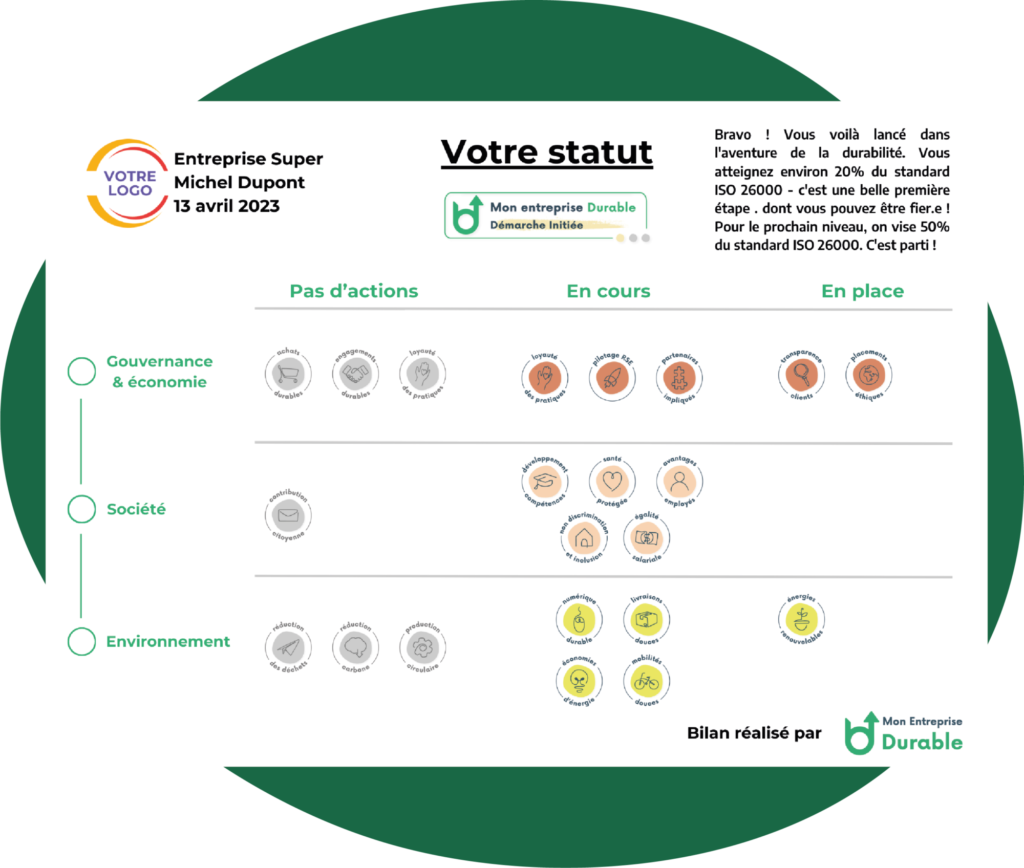Why implement a corporate CSR action plan?
Growing ecological awareness has made the implementation of a CSR strategy an important issue for companies.
It is the expression of their contribution to sustainable development.
However, adapting an already established operation to a new CSR policy is a complex process that needs to be carefully thought through.
The key element?
The action plan.
This is drawn up following a careful study of the company’s current situation, the objectives set and the desired impacts.
It can also evolve as social and environmental issues change.
It’s a genuine renewal of corporate culture and operations.
Our article gives you tips and advice on how to draw up an impactful CSR action plan for your company!
Key points of the article
Implementing a CSR approach in your company
CSR (Corporate Social Responsibility) puts sustainability at the heart of corporate life.
It is based on the 3 basic pillars of CSR: environmental, social and economic.
More precisely, CSR is divided into the 7 principles set out in the ISO 26000 standard:
- Governance
- Human rights
- Working conditions
- The environment
- Fair practices
- Consumer protection issues
- A focus on local development/social commitment
Integrating a CSR approach into your business is not only a major challenge, it’s also full of advantages for your company’s growth.
In fact, it can be entirely long-term and will have an impact on the company’s image.
A CSR policy enhances the company’s image, conveying a strong message and showing a conscientious structure with strong values.
It is a real point of difference in the marketplace.
In addition, CSR also enables savings to be made and waste to be limited, thanks to the actions decreed by the plan.
Finally, the company is more human and offers an inspiring working environment for employees.
The idea of drawing up a CSR action plan raises a number of questions.
The subjects on which to focus your CSR policy are just as varied: transparency, fairness, responsible reflexes, environmental protection, life in society.
Then it’s a matter of asking what the deeper meaning of the company’s activities is, and how to get everyone involved in achieving the new objectives.
There are many areas of CSR, and several positions can be envisaged.
After careful consideration, the action plan is drawn up to give concrete form to the company’s new guideline.
There are a number of stages involved in setting up a company’s CSR action plan.
The first is called “Diagnosis”.
This stage involves taking stock of the company’s current situation.
The diagnosis is based on the following pillars:
- Assess the company’s position with regard to the 3 CSR pillars: Governance, Environment and Society.
For example, the level of waste emissions, the fairness of the practices used, the employee satisfaction index… It’s also a question of observing whether certain CSR actions have already been implemented.
If so, what is their impact?
Companies often already have CSR initiatives in place, even without knowing it.
It’s rare to start out with no basis. - Define the common thread of the CSR strategy, its raison d’être.
- Identify strengths and weaknesses.
- Prioritize and define the project’s stakeholders.
Who will be involved in implementing this CSR policy?
How important are they? - Prioritize issues.
The diagnosis is first and foremost a basis for establishing the methodology for implementing your CSR action.
It determines the company’s level of maturity with regard to CSR issues, and is a co-construction process.
It can be carried out in-house, with the head of the company and qualified employees, but the diagnosis can also be carried out with external assistance.
In addition, employee awareness-raising initiatives can be envisaged.
The aim is to gather their opinions and draw up an action plan with which everyone can identify.
Formalize your CSR strategy and action plan
Once the diagnosis has been made and the strategy established, the next step is to formalize it.
This is an important step, as it will enable us to draw up the document that will embody your company’s new commitment.
It will serve as a means of communicating and asserting your commitments to external audiences.
The document formalizing your CSR action plan could therefore include, among other things, the following elements:
- The context of the action plan.
- The company’s commitments and raison d’être.
- Attachments illustrating the steps taken and the means used.
One of the elements of the formalization of the CSR strategy and action plan is also to ensure consistency between the desired policy and the ISO 26000 standard.
This is the only standard based on an international consensus on CSR.
It covers the key principles of responsible corporate conduct.
These include the 7 pillars of CSR set out above.
This standard provides a framework for all organizations establishing a new CSR strategy.
Based on this standard, the desired purposes can be defined as follows:
- Making a contribution to sustainable development, but also proposing improvements for life in society.
- Respecting the law, and possibly encouraging certain changes.
- Responding to stakeholders’ requests as effectively as possible.
The ISO 26 000 standard is a guideline given to companies throughout the implementation of the plan.
The company must ensure that it is in line as soon as the diagnosis is made.
Define and deploy your CSR action plan
Defining and deploying a CSR action plan are key stages in a CSR strategy.
They require investment from everyone involved, as well as careful monitoring.
Setting up the action plan not only highlights in detail the challenges and objectives to be met, but also the resources that will be required.
For example, the tools that will be used to monitor and plan the project, and the human and material resources required.
It’s a question of listing precisely the actions that will be implemented.
Managing all the initiatives and measuring their impact will be major issues.
The definition of a corporate CSR action plan is the culmination of the preceding stages.
Deployment is the final phase of your implementation.
It involves all the steps required to integrate the new policy into the life of the company.
The final objective is to make the new policy as widely known as possible.
The organization must make its new values and commitments known.
Information must be circulated both internally and externally.
Both are decisive factors in the successful integration of CSR into the organization.
Deployment mechanisms vary according to the company and the chosen course of action.
However, some are recurrent and particularly effective:
Awareness-raising: This stage has many advantages in being carried out before the action plan is deployed.
Even if it helps spread the word, its introductory role is optimal during the diagnostic phase.
It allows the company’s members to move forward with the project in mind, to adhere to it and even to get involved!
Employees who are convinced by the project will be better able to pass it on, both internally and externally.
The key is to present the project and its challenges in a clear and accessible way.
Introduce the subject and observe the reactions it provokes.
Emphasize the benefits and the interest stakeholders have in getting involved.
The importance of the issue at stake and the feeling of being useful are excellent vectors of transmission.
Train your team: having introduced the subject of awareness, it’s essential that the CSR policy permeates your company’s DNA.
It’s therefore a good idea to train managers and other department heads in CSR issues and the habits established by the action plan.
It’s important for them to be informed and committed to the new approaches, so that they can pass them on to their teams as effectively as possible!
Communication: this applies both internally and externally.
Make sure you regularly inform employees about the actions you’ve implemented and, above all, their results.
According to a study by the Observatoire, “Salariés et entreprises responsables” (Employees and Responsible Companies) in 2020, nearly 71% of employees feel that they are not well informed about the company’s CSR policy.
Externally, the stakes are the same.
The company needs to communicate frequently on its commitments and values, to enable the public to associate them with its image.
It is also important to ensure that customers have the means to find out about the actions taken and their impact.
Newsletter, magazine, report, press article, interview – any medium can be considered.
The most reliable alternative remains to establish a recurring periodic medium accessible to all.
Involving employees: this step is similar to the other two below.
In addition to awareness-raising and training, the aim is to familiarize employees with this new policy.
With events, for example, or by involving them actively in the project!
Communication will be the main lever for public deployment.
Internally, it relies mainly on employees and their feedback.
This is an opportunity to create a new dynamic based even more on people and trust.
All employees are mobilized, which can have a very positive effect on team solidarity!
The message can only be better conveyed to the outside world.
10 examples of CSR actions to implement
Deployment is underway, and your CSR policy is gradually gaining ground in people’s minds.
If, however, you have any doubts or need further inspiration, here’s a short summary of 10 CSR examples to put in place.
On the social front
The aim is to provide a healthy and ethical workspace.
The aim is to enable your employees to be productive in the best possible conditions.
Here are a few examples:
- Ensuring equal pay for men and women/promoting diversity.
- Offer teams sports and team-building activities.
- Provide pleasant workspaces.
( green, spacious…) - Consider shared internships.
(classic week of training, with one day dedicated to an activity to improve life in society)
On the economic front
The aim is to limit waste and turn to approaches that promote local products and quality.
Transparency and ethics are at the heart of these measures.
Here are a few examples:
- Give preference to local partners.
- Establish a responsible purchasing policy.
- Take an interest in the social economy.
On the environmental front
the aim is to reduce the company’s environmental impact.
The company can give priority to renewable methods and limit polluting processes as much as possible.
Here are a few examples:
- Adopt carpooling, draw up a travel plan to reduce CO2 emissions.
- More teleworking.
- Favoring renewable energies.
- Reduce water and paper consumption/practice recycling and sorting.
The steps involved may seem tedious, but CSR is full of benefits and enrichment for companies that choose to integrate it.
To conclude
In conclusion, implementing a corporate CSR action plan is a rich adventure on many levels.
It’s an opportunity for an organization to get involved in sustainable development issues with an approach that’s uniquely its own.
In addition to having a social, environmental and economic impact, the CSR action plan enables the company’s productivity to evolve.
The systems change, giving rise to a new production rhythm that can be just as effective, if not more so, than the old model!
It can also prove to be a great competitive advantage.
Are you interested in CSR?




